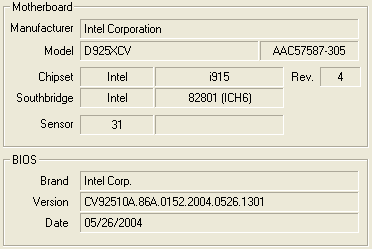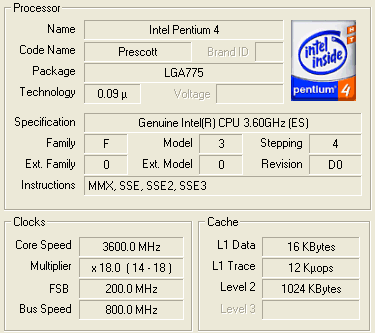System Setup and Notes
Hardware
ProcessorsIntel Pentium 4 Extreme Edition 3.4GHz, LGA775
Intel Pentium 4 Extreme Edition 3.4GHz, Socket 478
Intel Pentium 4 560, 3.6GHz, LGA775
Intel Pentium 4 3.4GHz 'Northwood', Socket 478
Intel Pentium 4 3.4GHz 'Prescott', Socket 478
AMD Athlon FX-51, Socket 940
AMD Athlon 64 Model 3800+, Socket 939
AMD Athlon 64 Model 3400+, Socket 754
Graphics Cards
NVIDIA GeForce 6800 Ultra, PCI Express 16x
NVIDIA GeForce 6800 Ultra, AGP8X
NVIDIA GeForce 6800 GT, PCI Express 16x
NVIDIA GeForce 6800 GT, AGP8X
ATI Radeon X600 XT, PCI Express 16x
ATI Radeon 9800 XT, AGP8X
Memory
1GB Micron DDR-II PC2-4300 - 4-4-4-12 - All LGA775 systems
512MB Corsair XMS3500C2 - 2-2-2-6 - All Socket 478 and Socket 754 systems
1GB Corsair XMS3200LLPT - 2-3-2-6 - All Socket 939 systems
1GB Corsair XMS3500RE - 2-3-2-6 - All Socket 940 systems
Hard Disks
2 x 250GB Maxtor DiamondMax 10 SATA pre-production, 16MB cache, NCQ
1 x 36.6GB Western Digital Raptor SATA
1 x 160GB Western Digital PATA
Motherboards
Intel D925XCV Desktop Board, Alderwood (i925X), LGA775, PCI Express 16x, DDR-II
Intel D915PCM Desktop Board, Grantsdale (i915P), LGA775, PCI Express 16x, DDR-II
ASUS SK8V, VIA K8T800, Socket 940, AGP8X, DDR-I
ASUS P4C800-E, Canterwood (i875P), Socket 478, AGP8X, DDR-I
ASUS K8V, VIA K8T800, Socket 754, AGP8X, DDR-I
MSI K8T Gem, VIA K8T800 Pro, Socket 939, AGP8X, DDR-I
Software
Windows XP Professional w/ SP1Intel Application Accelerator 4.0.0.6211 (LGA775 boards)
Intel 5.02.1002 chipset drivers (Socket 478 board)
Intel 6.0.0.1014 chipset drivers (LGA775 boards)
ATI CATALYST 4.1 (Socket 939, 940, 754, 478 boards using 9800 XT)
ATI CATALYST 4.6 BETA (LGA775 boards using X600 XT)
NVIDIA Detonator 61.34 (LGA775, Socket 940 boards using 6800-series)
VIA Hyperion 4.51v (Socket 939, 940, 745 boards)
DirectX 9.0b End User Runtime
HEXUS Pifast
Sciencemark 2.0
KribiBench v1.1
LAME 3.92MMX encoding U2's Pop album at 192CBR
Realstorm Raytracing Benchmark
3DMark 2001SE
3DMark03
Painkiller
HDTach 3.0.0
Notes
First off, there's some CPU emulation going on with a couple of CPUs. The Pentium 4 560 was used to emulate everything from the 520 to the 560, five processors in total from 2.8 to 3.6GHz. The FX-51 was used to emulate an FX-53, forward multiplier adjustment being available on Athlon FX processors.Past that, the Grantsdale board was only benchmarked with the Pentium 4 560 at Pentium 4 520 speeds (2.8GHz) due to the BIOS not recognising the CPU properly.
The X600 XT was used for the non-3D benchmarks on the LGA775 PCI Express 16x boards, 9800 XT used for non-3D benchmarks on everything else. The NVIDIA 6800-series cards were used for the 3D gaming tests on the Socket 940 and LGA775 systems.
The PATA 160GB disk was used to boot the Socket 939 and Socket 478 boards, the Raptor being used to boot everything else. The Maxtor disks were only used to test the Matrix Storage subsystem.
Keep the memory timings for each set of modules in mind when examining the memory subsystem tests, they have an effect on overall performance.
The new platform basically goes up against its closest rivals in a few scenarios, giving the performance results a quad focus. Firstly, note the CPU scaling performance of the 5xx-series Pentium 4 processors on Alderwood. Secondly, note the 3.4EE LGA775 performance against its high-end peers (FX-51, FX-53, Model 3800+ and the 3.4EE on Socket 478). Thirdly, note the Pentium 560 performance up against its main peers (3.4 Northwood and Prescott on Socket 478 and Model 3400+). Finally, compare Pentium 4 520 performance on Alderwood and Grantsdale, to see the current differences between the two chipsets.
Hyper-Threading was on at all times for the Pentium 4 systems. If a system could be run in dual-channel memory mode (everything bar the Socket 754 system running Model 3400+), it was.
Let's get on to the memory and CPU subsystem testing first, followed by the 3D tests, with the disk subsystem performance of the Matrix Storage subsystem bringing up the substantial rear.
CPU-Z
CPU-Z saw the Alderwood motherboard, the DDR-II memory and the Pentium 4 560 as follows.











